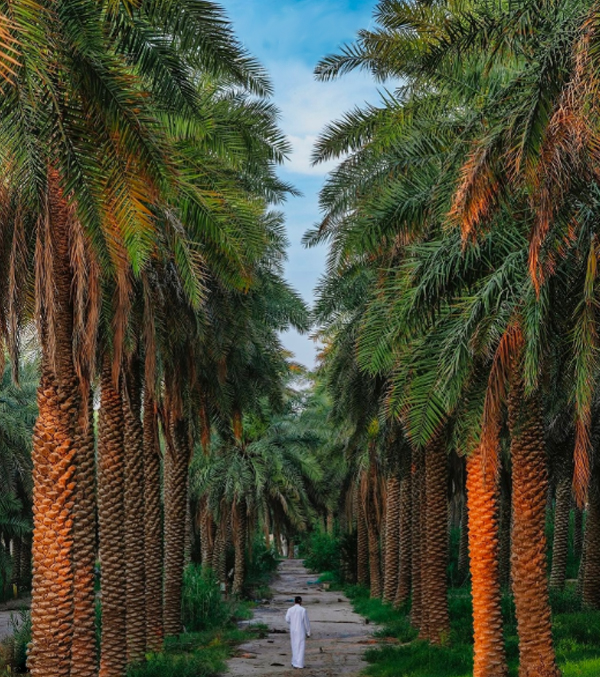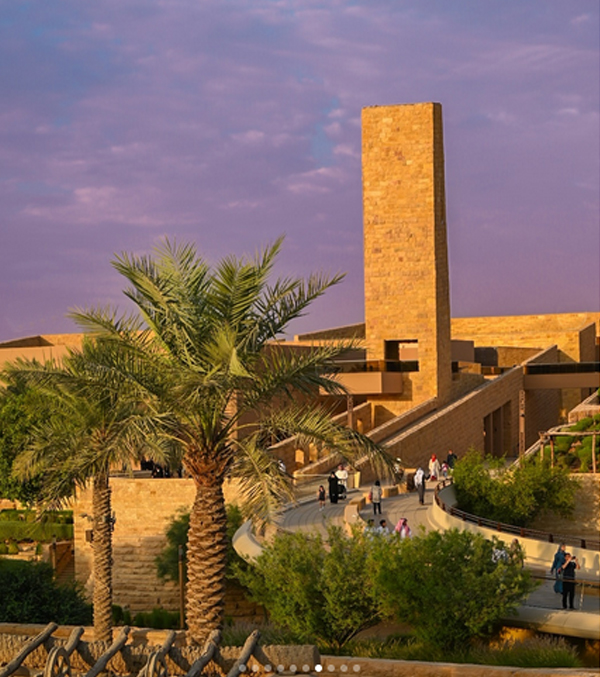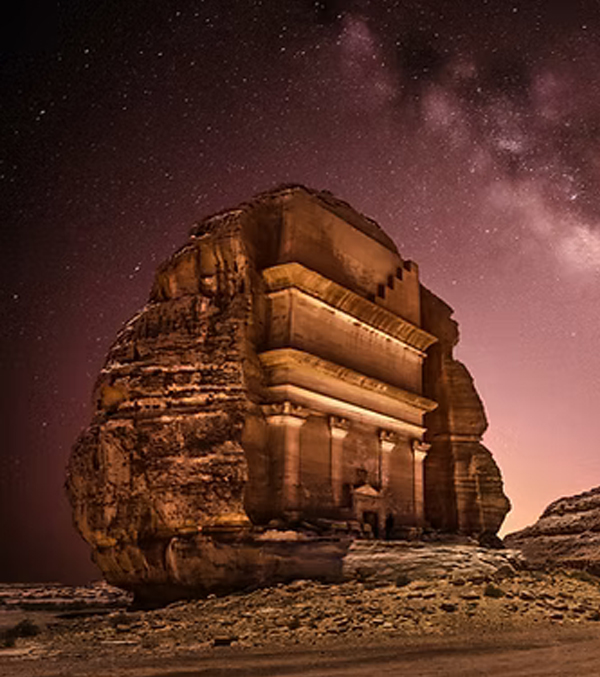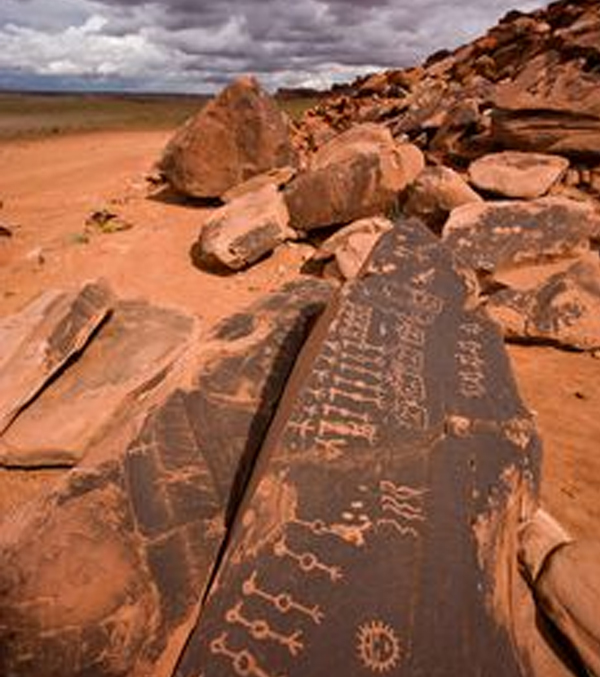Journey from Amman to Wadi Rum
Saudi Arabia’s UNESCO World Heritage Sites
Al-Ahsa Oasis: The Green Heart of the Desert
Nestled in the Eastern Province, Al-Ahsa Oasis is one of the world’s largest oases, recognized by UNESCO in 2018 for its cultural and agricultural significance. Spanning over 85 square kilometers, this verdant expanse is a marvel of human ingenuity, with over 2.5 million date palms irrigated by ancient springs and a sophisticated falaj system. Historically, Al-Ahsa was a vital stop on trade routes, connecting the Arabian Peninsula to Mesopotamia and beyond, fostering a blend of cultures evident in its archaeological sites and traditional souqs.
Visitor Experience: Visiting Al-Ahsa feels like stepping into a living museum. Start at the Al-Qaisariya Souq, where the aroma of spices and the chatter of vendors create a sensory delight. Explore the Ibrahim Palace, a 16th-century fortress blending Ottoman and Islamic architecture, or wander through the palm groves to witness farmers tending to date harvests. The oasis’s cooling springs, like Ain Najm, offer a refreshing dip, especially in the milder months of November to February. Guided tours provide insights into sustainable farming practices, while local eateries serve delicacies like hasawi rice dishes paired with fresh dates. For Pinkstone travelers, we recommend a sunset camel ride through the groves for a serene end to the day.
Historical Significance: Al-Ahsa’s enduring agricultural systems and its role as a cultural crossroads highlight human resilience in harsh desert environments. Its inclusion on the UNESCO list underscores its global importance as a testament to sustainable land use and cultural exchange.


Historic Jeddah: The Gateway to Mecca
Historic Jeddah, or Al-Balad, inscribed in 2014, is the beating heart of Jeddah’s cultural heritage. As the historic port for pilgrims en route to Mecca, this coastal city on the Red Sea became a melting pot of cultures, with influences from Africa, Asia, and the Levant. Its coral-stone buildings, adorned with intricate wooden mashrabiya balconies, date back to the 7th century, reflecting a unique Hijazi architectural style. Narrow alleys lined with souqs and merchant houses tell stories of trade and pilgrimage.
Visitor Experience: Walking through Al-Balad is like strolling through history. Begin at the Nassif House, now a museum showcasing Jeddah’s heritage, with its carved teak panels and airy courtyards. The Al-Shafei Mosque, one of the city’s oldest, offers a glimpse into Islamic architecture, while the bustling Souq Al-Alawi tempts with handmade jewelry, perfumes, and traditional abayas. Street food vendors serve shawarma and tamarind juice, adding flavor to the exploration. Pinkstone Travel suggests a guided evening tour when the coral houses glow under lantern light, paired with a visit to a rooftop café for panoramic views. The Jeddah Season, if timed right, adds concerts and cultural events to the itinerary.
Historical Significance: Jeddah’s role as a pilgrimage and trade hub shaped its cosmopolitan character. Its preservation as a UNESCO site ensures that its architectural and cultural legacy endures amidst the city’s modern skyscrapers.
Diriyah: The Birthplace of Saudi Arabia
Diriyah, inscribed in 2010, is the ancestral home of the Al Saud dynasty and the cradle of the First Saudi State, founded in 1727. Located on the outskirts of Riyadh, this adobe city along the Wadi Hanifa was a political and religious center, with its mud-brick palaces and mosques reflecting Najdi architecture. The At-Turaif district, the heart of Diriyah, showcases the kingdom’s early governance and cultural roots.
Visitor Experience: Diriyah’s restoration has transformed At-Turaif into an open-air museum. Visitors can explore the Salwa Palace, once the seat of power, with its intricate mud-and-straw walls. The Diriyah Museum offers artifacts and multimedia displays tracing the Saudi state’s origins. Walking tours reveal hidden courtyards and watchtowers, while the surrounding wadi offers scenic trails. For a cultural immersion, Pinkstone recommends visiting during the Diriyah Season, featuring traditional music, crafts, and falconry displays. Nearby, Bujairi Terrace’s restaurants serve Najdi dishes like jareesh and qursan, blending history with culinary delight.
Historical Significance: Diriyah symbolizes Saudi Arabia’s unification and cultural identity. Its UNESCO status highlights its role in shaping the Arabian Peninsula’s modern history, preserving a legacy of governance and resilience.


Hegra (Mada’in Saleh): The Nabataean Marvel
Hegra, inscribed in 2008 as Saudi Arabia’s first UNESCO site, is the southern capital of the Nabataean Kingdom, often compared to Jordan’s Petra. Located in AlUla, Hegra boasts over 100 monumental tombs carved into sandstone cliffs, dating back to the 1st century BCE. These tombs, adorned with intricate facades, reflect the Nabataeans’ wealth from incense trade routes. The site also includes wells, banqueting halls, and inscriptions, offering a window into a sophisticated ancient civilization.
Visitor Experience: Hegra captivates with its surreal desert setting. Guided tours, often by 4×4 or bicycle, take visitors through key sites like the Qasr Al-Farid, a solitary tomb glowing at sunrise. The Jabal Ithlib, a sacred Nabataean precinct, and the ancient Diwan meeting hall add depth to the experience. Pinkstone suggests a photography tour at dawn or dusk for stunning light effects, followed by a stargazing session in AlUla’s clear skies. Local guides share stories of Nabataean life, while nearby AlUla Old Town offers cafés serving Arabic coffee and date pastries. Events like Winter at Tantora bring music and art to the region, enhancing the visit.
Historical Significance: Hegra’s tombs and trade networks highlight the Nabataeans’ architectural prowess and economic influence. As a UNESCO site, it underscores Saudi Arabia’s role in ancient global commerce.
Rock Art in the Hail Region: Ancient Stories in Stone
The Rock Art in the Hail Region, inscribed in 2015, encompasses two sites—Jabal Umm Sinman at Jubbah and Jabal Al-Manjor/Raat at Shuwaymis. These open-air galleries feature thousands of petroglyphs and inscriptions spanning 10,000 years, depicting human figures, animals, and hunting scenes. Created by prehistoric and early historic communities, the carvings reflect environmental changes and cultural evolution in the Arabian Peninsula.
Visitor Experience: Visiting the Hail Region’s rock art is an adventure into the remote desert. Jubbah, surrounded by sand dunes, showcases vivid carvings of ibex, ostriches, and warriors, best seen on guided tours that explain their context. Shuwaymis, less accessible, requires a 4×4 journey but rewards with intricate panels under rocky overhangs. Pinkstone recommends pairing the visit with a stay in Hail city, where the A’arif Fort and local souqs offer additional cultural immersion. The desert’s stark beauty and the carvings’ ancient narratives create a profound experience, especially for history enthusiasts. Bring sturdy shoes and sun protection, as sites involve light hiking.
Historical Significance: The rock art documents millennia of human adaptation to a changing landscape, from lush savannas to arid deserts. Its UNESCO recognition celebrates its universal value as one of the world’s richest rock art collections.

Practical Tips
Planning Your UNESCO Journey
Each of these UNESCO sites offers a distinct perspective on Saudi Arabia’s heritage, from Al-Ahsa’s agricultural ingenuity to Hegra’s ancient grandeur. For the best experience, travel between November and February when temperatures are cooler, averaging 15–25°C. Pinkstone Travel Saudi crafts tailored itineraries, combining these sites with modern attractions like Riyadh’s Souq Al-Zel or Jeddah’s Red Sea coast. Our packages include expert guides, comfortable transport, and curated dining, ensuring a seamless journey.
Practical Tips:
- Visas: Obtain an e-Visa via the Visit Saudi website, valid for tourism and cultural visits.
- Dress: Respect local customs with modest clothing, especially in historic areas. Women may need a headscarf in religious sites.
- Connectivity: Purchase a local SIM for navigation, as some sites are remote.
- Sustainability: Support eco-friendly tours to preserve these delicate sites for future generations.
Tour Operator
Travel Agency in Riyadh
Exploring Saudi Arabia’s UNESCO World Heritage Sites
Saudi Arabia’s UNESCO World Heritage Sites are more than destinations—they are portals to a civilization’s triumphs, trade, and traditions. Whether marveling at Hegra’s tombs, wandering Jeddah’s coral alleys, or tracing ancient carvings in Hail, travelers with Pinkstone Travel Saudi will uncover the kingdom’s soul. These sites, preserved for their universal value, invite you to explore a nation where history and hospitality intertwine, creating memories as timeless as the desert itself.
At Pinkstone Travel Saudi, we’re dedicated to helping you craft unforgettable journeys. Contact us to customize your Saudi Arabia’s UNESCO World Heritage Sites with guided tours, accommodations, and insider tips. Discover her Saudi Arabia Travel Guide and Safe travels, and may the desert’s magic captivate your soul!
